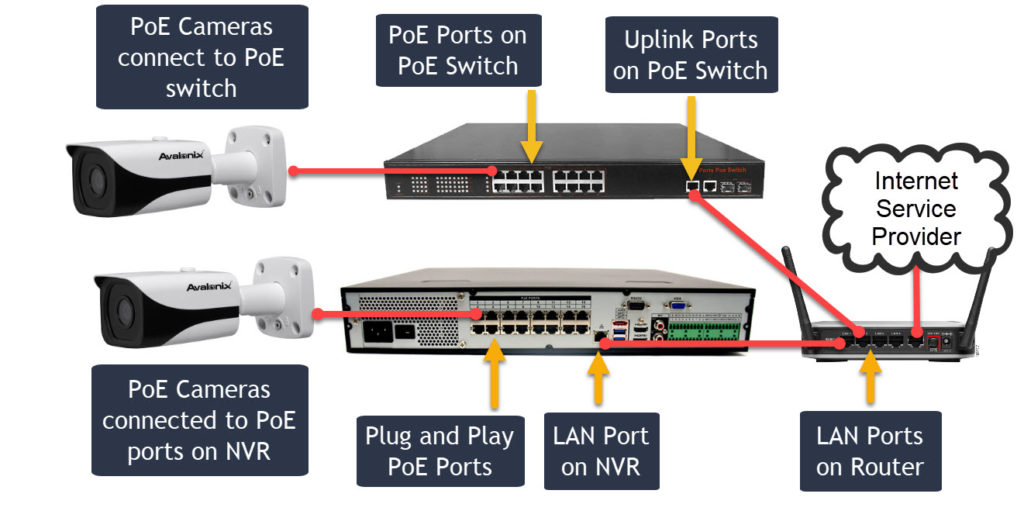
Security cameras are gaining popularity among homeowners and businesses small and large. This trend is largely due to emerging technologies that make surveillance systems more affordable and user-friendly. A key technology in this respect is Power over Ethernet (PoE), which delivers both power and data over a single cable. PoE technology simplifies the setup process for professional-grade security camera systems, making them accessible to a wider audience.
What are PoE security cameras?

PoE cameras, also known as network or IP security cameras, are surveillance devices designed with integrated Power over Ethernet (PoE) technology. PoE enables these devices to receive power and transmit video data over a single network cable. The consolidation of power and data transmission into one cable makes PoE cameras an excellent choice for any security camera system installation.
However, it's important to note that not all IP cameras are equipped with PoE technology, and those without it require separate power adapters. These cameras are typically larger PTZ or motorized zoom cameras that have power requirements that PoE cannot support. Professional WiFi security cameras also lack PoE and require an external 12V DC adapter for power.
When paired with a compatible network video recorder (NVR), PoE cameras offer a "plug-and-play" experience, eliminating complex setups or configurations. This user-friendly approach allows individuals of all technical abilities to install security cameras for their homes or small businesses. By leveraging PoE and plug-and-play technology for self-installation, our customers have saved thousands of dollars by bypassing the need for professional CCTV installers.
If you’re completely new to PoE cameras, the following video we made will provide a quick overview of how IP PoE cameras work.
How is a PoE security camera system different from other CCTV systems?
To fully understand PoE camera systems, it’s important to know about the other types of CCTV security systems. These systems differ in how cameras connect and the type of wiring they use. Here's a brief overview of the categories of systems:
Analog/HD Coax Security Systems
Generally referred to as analog security systems, they use coaxial cable, and modern ones can record digital HD (high definition) video. These systems require a DVR (digital video recorder) to analog video into digital form to record to a hard drive. Analog cameras need two separate cables to work: one for video transmission and another for power. Although Siamese coaxial cable integrates the two, it's not as convenient as PoE due to the separation of wires and a separate power supply. While still in use today, analog cameras lack the superior features and video quality offered by PoE cameras.
IP Camera Systems
IP (Internet Protocol) cameras use computer networking cables and protocols to transmit video digitally to an NVR (network video recorders), computers, or smartphones. Unlike analog cameras, IP cameras can operate independently without a recorder for standalone recording. They don't require an internet connection to function, despite the term "IP." An internet connection is only needed for off-site viewing. Both PoE cameras and WiFi security camera systems fall under the IP camera category.
PoE Camera Systems
PoE systems use IP cameras with built-in PoE technology, which enables cameras to receive power from and transmit video data back through the same cable. NVRs in a PoE system usually have an internal PoE switch that the cameras connect to. If the NVR and cameras are compatible, the cameras will automatically power on, connect, and start recording within a few minutes. PoE cameras are the pinnacle of convenience, reliability, and quality in the surveillance industry.
Wireless WiFi Camera Systems
These systems use WiFi IP network technology, similar to that used in smartphones, tablets, and laptops. Although some wireless cameras can run on batteries or solar power, the more reliable and powerful ones, like those we sell, require special power adapters. This means the cameras need a power outlet nearby. WiFi security cameras work best when obstructions between the WiFi router and cameras are minimal. Depending on the particular project, they can be well suited for professional or commercial security camera systems, or homes and barns.
How does a PoE security camera system work?
To install and use a PoE camera system, only a few components are needed:
- PoE cameras
- Network video recorder (NVR)
- Ethernet cables such as CAT5e or CAT6
- For some systems, an additional external PoE switch
- A TV or monitor to see the output of the system - remote viewing using phones or computers is possible after the setup
In a PoE system, the camera encodes the video before sending it to the NVR for recording or remote viewing. There are two types of systems: plug-and-play and those that work over local computer networks.
Plug-and-Play
In a plug-and-play system, the NVR has a built-in PoE switch. Compatible cameras connect directly to the back of the NVR. An Ethernet cable connects a camera directly to the built-in PoE switch on the NVR. For example, 4-channel NVRs have a 4-port PoE switch that can connect to up to four cameras. 8-channel, 16-channel, and 32-channel NVRs with built-in switches also exist. These types of security camera recorders are called PoE NVRs.
However, due to space and power limitations, 32-channel NVRs usually have switches with only 16 ports, requiring additional cameras to connect over a computer network.
Plug-and-play systems simplify the installation and setup of a security camera system because they do not need to be set up or configured; the cameras simply power on and send video within a few minutes of being connected.
Over a Local Network
PoE camera systems can also operate over a local network with external PoE switches. This setup is more challenging because each camera requires configuration and is not plug-and-play.
External switches typically feature a set of PoE ports to provide power and data to end devices like cameras. The other ports, known as "uplink" ports, connect to other networking equipment, such as a modem, router, or other network switches. Ethernet cables connect the cameras to the PoE ports on the switch. More Ethernet cables are needed to connect the switch or switches to other networking equipment.
In this type of system, the NVR can be located anywhere within the network, with cameras sending their data through the switches and network infrastructure. Each camera requires a unique IP address on the local network, which can be a daunting task for anyone who is unfamiliar with computer networking. For those willing to learn and seeking more information on network camera systems, our detailed guide on How to Setup a Security Camera System on the Network is available.

What are the advantages of a PoE security camera system?
PoE technology has revolutionized the surveillance industry by simplifying the setup of security camera systems for homes and businesses. Even those with little technical knowledge can get a plug-and-play system up and running by running Ethernet cables themselves or hiring a handyman. Those with networking and IT knowledge can leverage the flexibility and ease-of-use that PoE technology brings to a network-based camera system.
High-Quality Footage
IP PoE cameras come equipped with their own internal computer processors responsible for encoding the video footage. This allows PoE cameras to record video at higher resolutions and frame rates than analog or coaxial cameras. Moreover, the all-digital video signals prevent signal loss or degradation that can occur with coax systems. The result? Clearer video footage for investigations and prosecutions. Plus, network cameras significantly improve digital zoom capabilities, providing a clearer view of faces and license plates.
Flexibility
Ethernet cables are less bulky and rigid than coaxial cables, making them easier to install and suitable for more challenging locations. Although Ethernet only works up to 328 feet away, PoE extenders can be used to overcome this limitation. For network-based systems, PoE switches feature uplink ports that can be daisy-chained. Conversely, coaxial cables can only be extended by using couplers that result in signal loss or by running a new, longer cable altogether.
Enhanced Features
The internal computer hardware of PoE cameras also means they offer more features than coaxial cameras. This hardware provides processing power for features like Smart Detection, which uses AI technology to detect objects in real-time as video is recorded. Other capabilities include two-way audio, live streaming, vehicle and person detection, face detection, and more. Additionally, some IP cameras have microSD card slots for standalone use or on-board storage in the event the NVR is stolen.
What features should you consider in a PoE security camera system?
Selecting a PoE security camera system that best meets your needs can be challenging given the wide variety of options and features available.
Video Resolution
IP cameras were the first security cameras to use the megapixel (MP) rating commonly associated with digital photography cameras. The MP rating corresponds to the video resolution a camera can capture. This resolution defines the level of detail the camera can record and the effectiveness of digital zoom before images become pixelated and blurred. The three most popular resolutions include: 2MP 1080P, 4MP 2K, and 8MP 4K.
For many people, these resolutions and MP ratings might not mean much, so it's useful to explain how much facial detail each resolution can capture. We suggest incorporating different resolutions into your system to accommodate varying requirements. Opt for 8MP 4K cameras where you need to recognize faces up to 50 or 70 feet away. For areas where detailed facial recognition is less critical, lower resolutions like 2MP 1080P or 4MP 2K should suffice. You can learn more about the differences between camera resolutions and features in our Security Camera Buying Guide.
Night Vision Capability
Night vision cameras typically record black-and-white video using IR night vision or Starlight technology. Buying a camera with 100 feet of IR night vision doesn't necessarily mean you can see full detail at that distance; it just means the camera can project infrared light that far.
Starlight technology, sometimes marketed as "color night vision," enhances the image sensor's light sensitivity, allowing the camera to stay in color mode with sufficient ambient lighting. Starlight cameras usually have IR LEDs and switch to black-and-white mode when there is not enough light to stay in color mode.
If you need to capture faces or fine details more than 60 feet away from a camera at night, consider a motorized zoom or PTZ camera that offers over 200 feet of night vision.
Remote Viewing
Whether you're a business owner, manager, or homeowner, remote viewing is an excellent feature for monitoring your property. Though remote access is generally standard with modern surveillance systems, there are essential considerations for a PoE camera system with remote viewing apps. These include potential monthly fees, push notifications, easy setup via QR code without complex port forwarding, and remote viewing capabilities with PC or Mac software. Notably, all of CCTV Camera World's cameras and systems provide these viewing features at no additional cost!

